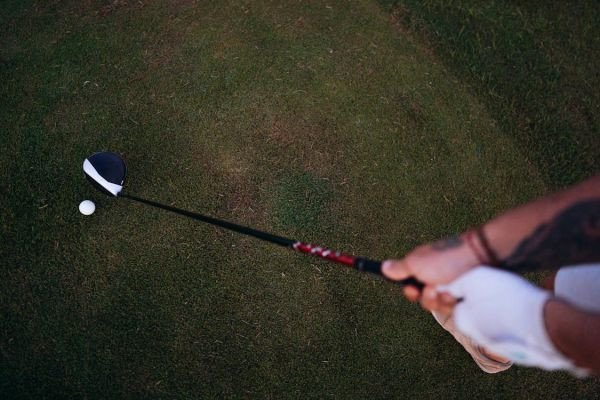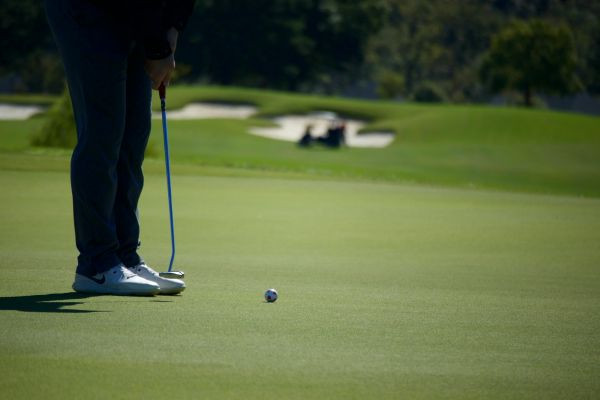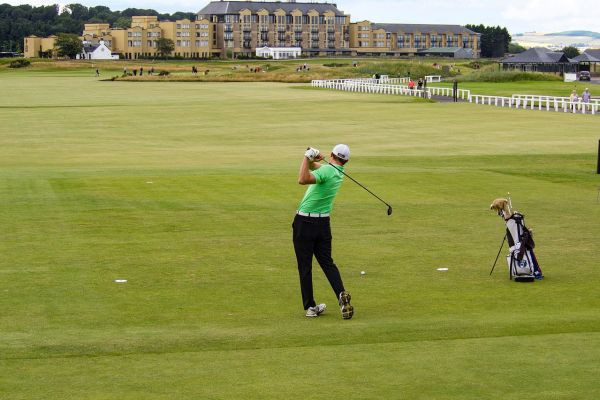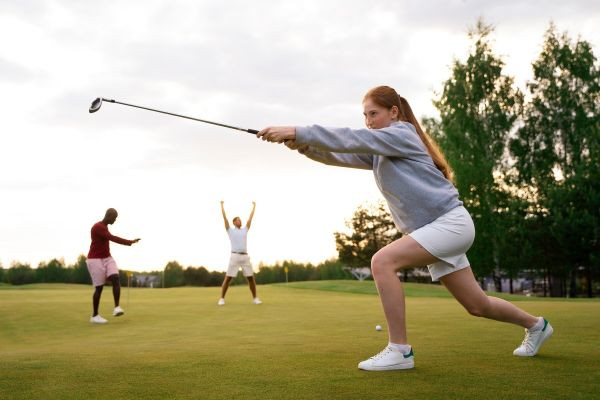How to Determine the Right Moment for Wrist Roll in the Downswing?
Ever found yourself pondering when exactly you should start rolling your wrist in the golf swing's downswing? You're not alone. It's a crucial element that can significantly impact your swing's outcom..

Ever found yourself pondering when exactly you should start rolling your wrist in the golf swing's downswing? You're not alone. It's a crucial element that can significantly impact your swing's outcome, affecting everything from the shot's direction to its power. This article dives deep into the art of mastering wrist roll timing, ensuring you hit your golf shots with more precision and consistency.
The Importance of Wrist Action in Golf
In the whole spectrum of golf swing dynamics, wrist movement has an important function. It provides essential control over the club. This function is significantly important at the moment of truth—the moment of impact or when striking the golf ball.
All angles related to the path of club movement in relation to the club’s face are all attributed to the function of the wrist. The path of the club is clearly dependent on the force, speed and control the club executed in harmony with the wrist movement.
Many other factors are related to the wrist at one point or another in the swing, evident most in the follow through. Analysis of the follow through and respecting its importance will directly affect the quality of the golf shot and the games the golfer will play in accordance.
Anatomy of the Downswing
To truly grasp the significance of wrist action one must delve into the anatomy of the downswing. This phase is where the magic happens where potential energy is converted into kinetic energy propelling the golf ball towards the green. The downswing begins the moment the club changes direction from its apex and starts its descent towards the ball. This phase is crucial for several reasons:
Speed Generation: It's during the downswing that the golfer's body and club work in unison to generate speed. The wrists play a pivotal role here acting as a hinge that amplifies the power transferred to the ball.
Direction Control: The path of the club and the orientation of the clubface at the moment of impact are largely determined during the downswing. Wrist action is instrumental in adjusting these factors ensuring the clubface is square to the ball at impact thus dictating the shot's direction.
Fine-tuning the Shot: The downswing is the golfer's last opportunity to make minor adjustments to their swing to affect the shot's outcome. The wrists allow for this fine-tuning offering the golfer a chance to correct or optimize the shot's trajectory and spin.
The Mechanics of Wrist Roll

Source:https://www.pexels.com/photo/a-golfer-holding-a-golf-club-driver-9207654/
Types of Wrist Movements
Extension/Flexion: These are vertical movements of the wrist where extension refers to the upward bending of the wrist increasing the angle between the back of the hand and the forearm. Flexion conversely is the downward bending decreasing this angle.
These movements are paramount in controlling the clubface's opening and closing directly influencing the shot's direction. Mastery of extension and flexion allows golfers to adjust the clubface angle at impact crucial for hitting the ball squarely and directing it towards the intended target.
Radial Deviation/Ulnar Deviation: These movements involve the wrist bending towards the thumb (radial deviation) or towards the pinky side (ulnar deviation) akin to a nodding motion. This nodding action plays a significant role in the swing's power generation. It's involved in creating and releasing lag, a key element in adding speed to the swing.Mastering radial and ulnar deviations can significantly boost the speed of your club head when it connects with the ball leading to more powerful shots.
Pronation/Supination: These movements involve rotating the forearm and hand. Pronation refers to inward rotation, where the back of the hand faces downward while supination involves rotation with the palm turning sideways. These actions impact how the clubface aligns, at impact crucial for controlling spin and trajectory. Properly utilizing pronation and supination can help correct hooks and slices enhancing shot accuracy.
How Wrist Roll Affects Your Swing
The timing and accuracy of a wrist roll play a significant role in determining how the golf ball travels. A well executed wrist roll that incorporates extension/flexion, radial/ulnar deviations and pronation/supination can significantly improve shot trajectory, spin control and distance. Here's how it works:
Trajectory Control: By manipulating the wrist roll to control the clubface angle at impact golfers can change launch angles to hit lower shots as needed. This skill is essential for navigating obstacles like trees or achieving landings, on greens.
Spin Adjustment: The way your wrist moves can greatly affect how the clubface aligns when you hit the ball, which is crucial for controlling spin. Using your wrist correctly can help create the amount of spin for better shot control or reduce side spin that leads to hooks and slices.
Distance Maximization: By using your wrists by creating and releasing lag (through radial and ulnar deviations) you can significantly boost the distance of your shots. Mastering the movement of your wrists is key for golfers aiming to add yards to their drives.
Timing Your Wrist Roll
Identifying the Maximum Lag Position
In golf 'lag' refers to the angle formed between the club shaft and your lead forearm. Maximizing this angle is important for generating speed and power in your swing. The peak lag position happens during the downswing before transitioning into impact. At this point your wrists are still cocked, storing up energy that will be unleashed upon contact with the ball.
Recognizing when you reach the lag position is crucial. It signals that it's time to start rolling your wrists preparing for an impact. This particular moment calls for focus and consistent practice to recognize, as letting go of the lag soon or too late can reduce the strength and precision of your shot. Visual cues, muscle memory and regular practice play a role in mastering the timing of releasing this stored energy for impact.
The Transition Phase
Moving from the swing to the follow through marks a moment in a golf swing. It's at this point that the direction of movement shifts and the preparations for impact are finalized. The rotation of the wrists during this phase is essential to ensure a clubface at impact. A timed and precise wrist rotation can address flaws in the swing path aligning the clubface perfectly with the target.
Getting the wrist rotation during the transition phase requires a balance between maintaining lag and initiating wrist movement. The aim is to preserve lag as possible before smoothly transitioning into wrist rotation aligning the clubface as it approaches the ball. In this stage the key factors are practice and intuition as timing can vary slightly among golfers depending on their swing speed and technique.
The Moment of Truth: Impact
Contact is the peak of your golf swing, where every adjustment, motion and choice is put to the test. The precise timing of your wrist rotation is crucial, in this phase since it directly impacts the clubface angle when it meets the ball. A timed wrist rotation ensures that the clubface is square at impact leading to a shot that travels accurately in your desired direction.
The moment of contact is brief yet pivotal in your swing. It's the instant where the effectiveness of your wrist rotation is gauged by how the ball flies. To ensure your wrist rotation aligns perfectly for impact, concentrate on the sensation of the swing. The feel of the clubhead position of your wrists and feedback from practice swings can help you refine your wrist timing, for that moment of truth. Exercises, for Enhancing Your Wrist Action
Drills to Improve Your Wrist Action
The Motorcycle Drill
This drill known for simulating the movement of revving a motorcycle throttle is great for sensing the wrist flexion. To practice this, hold a club. Execute your swing. When you reach the phase rotate your leading wrist as if twisting a motorcycle throttle towards yourself. This action promotes wrist flexion resulting in a powerful impact stance. It's a method to grasp the sensation of maintaining a clubface at impact.
The Hinge and Rehinge Drill
This exercise aims to comprehend the motion of the wrists during the swing. Begin without a ball by positioning your club through a swing. Raise your wrists up in a hinge motion then bring them through an imaginary impact area. The objective is to create a movement that highlights the hinge and unhinge action of your wrists. This drill aids in understanding how the wrists contribute to strength and precision throughout the swing.
Common Mistakes to Avoid
Over-Rotation: While wrist rotation is essential it's crucial not to overdo it. Overdoing the rotation can disrupt the balance of your swing causing your shots to vary in outcome. Concentrate on making deliberate and controlled wrist movements to keep your swings consistent.
Timing Misconceptions: Many golfers make a mistake by misjudging when to roll their wrists either doing it too soon or too late. This interrupts the fluidity of the swing. Can have an impact on accuracy at impact. Practicing drills and being mindful during repetition are crucial, in overcoming this obstacle ensuring that your wrist movement aligns with the flow of your swing.
Conclusion
In conclusion, knowing when to use a wrist roll in the downswing involves a combination of several factors. It involves a synergy of body movement, skill and developing a sense for where you are in the arc of the swing over time. It's not difficult to understand the mechanics of the wrist roll. However by practicing diligently and acquiring an understanding of wrist sensation you will achieve a more sophisticated feel for the increasing lag pressure you are trying to accomplish. After all, golf is a journey in which we continuously improve.
Frequently Asked Questions (FAQs)
What is the most common mistake when rolling the wrist in the downswing?
Misjudging the point at which the club rolls and how the club rolls are common issues. A vast majority tend to believe the club rolls much faster through the second half of the swing rather than a gradual roll from the top all the way to the ball. The end result? The clubface's position and its action through impact are often misjudged negatively and therefore affect the accuracy of golf shots.
How can I practice improving my wrist roll at home?
The best way to improve your wrist roll at home is to do some simple drills that will help you understand the motion and feel of the wrist action. A couple good drills to practice at home are the Motorcycle Drill and the Hinge and Rehinge Drill. These drills are extremely effective because they don't require hitting balls; instead, you can simply focus on the wrist motions.
Does wrist roll differ for driving and putting?
Yes, the application and emphasis on wrist roll differs significantly. With the driver, one must apply wrist roll more significantly to generate maximum power and control the shot's trajectory. On the other hand, when putting, the wrist roll is applied more delicately since power is less of a concern compared to the need for precise control and feel.
Is it possible to have a good golf swing without perfecting wrist roll?
It's possible to possess a proficient golf swing even without mastering or explicitly focusing on the nuances of wrist roll. However, to achieve the range, accuracy and consistency you desire in your game, it's crucial to have your wrist roll in check. I’ll explain why. Simply put the wrist roll is a critical factor in ensuring the clubface correctly contacts the golf ball at impact in its simplest form.
How long does it take to see improvements in wrist roll technique?
The improvement in your wrist roll should take anywhere from two to four weeks. Although this could be earlier if you have high quality practices, it also could take longer if you practice everyday but do not work on the components of your role such as grip pressure or swing shape. As every golfer differs in their ability to adapt to new movements, there is no definitive timeframe for seeing improvement in your wrist roll.
Can wrist roll adjustments help fix a slice or hook?
Without a doubt wrist roll adjustments are a key tactic in fixing a slice and hooks. By making slight changes to their wrist motion, golfers can change the clubface’s angle at impact which will ultimately fix their slices or hooks by addressing the cause of the issue directly.








































































